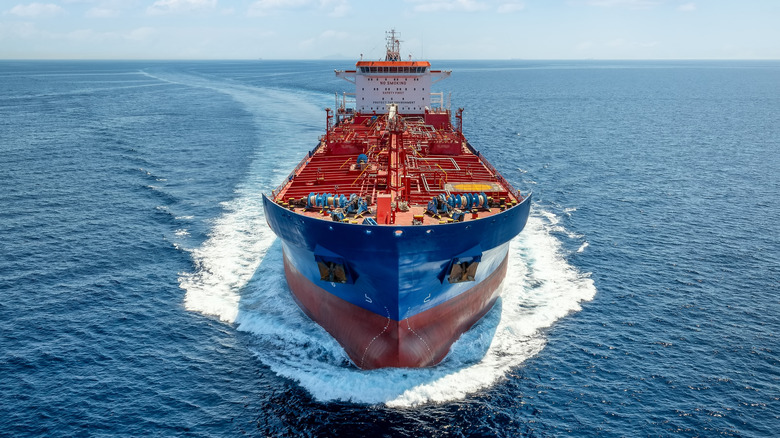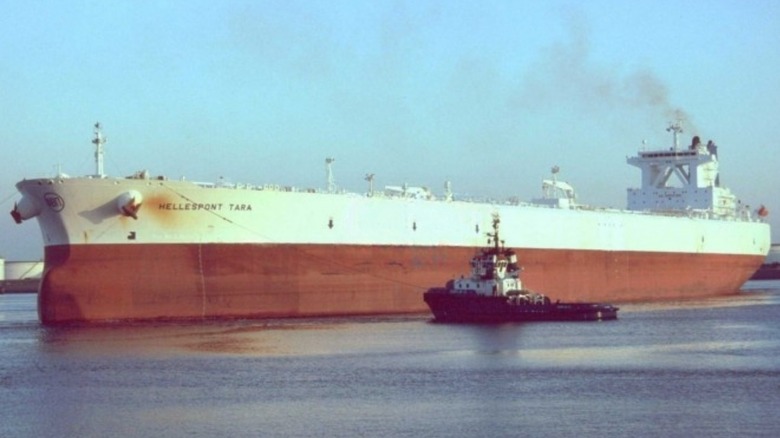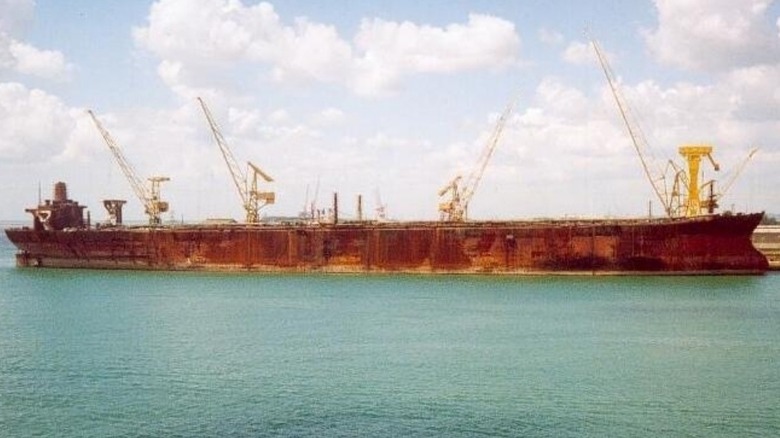What Is The Largest Oil Tanker In The World And How Much Oil Can It Carry?
Oil tankers are some of the most economically important naval vessels operating today, and they've been around for a long time. The first oil tanker was the Zoroaster, which was built all the way back in 1878. Since then, oil tankers have grown in both size and complexity. Today's vessels are monstrous behemoths compared to those that came before them. Unless you work in the industry, most people don't think or hear about oil tankers unless there's a problem, which sadly happens every couple of decades.
Many likely recall the Exxon Valdez disaster which is only one example of how such large vessels can be damaging when things go wrong. Size is definitely a factor in oil tanker construction as it's necessary to move a tremendous amount of crude oil across the world's oceans to refineries so folks can pump gasoline into their vehicles. The largest oil tanker in the world is the FSO Oceania and it's a beast of a ship. The Oceania has a crude oil capacity of 3 million barrels.
If that sounds like a lot of oil, it most certainly is, but it's only a drop in the bucket in terms of daily consumption. In 2023, the United States consumed an average 20.25 million barrels of petroleum a day, amounting to nearly 7.4 billion barrels annually. Oil tankers are as massive as the Oceania because they need to be or developed countries wouldn't be able to operate as they currently do thanks to their high energy requirements. Still, while Oceania is huge, it's not the biggest oil tanker ever constructed.
The FSO Oceania
The FSO Oceania is classified as an Ultra-Large Crude Carrier (ULCC) and is the world's largest crude oil tanker currently in operation. She was built by Hellespont Fairfax in 2003 and is currently owned by Euronav Shipping NV. The ship has undergone several name changes over the years. She has several sister ships of the same size (pictured), but the Oceania is the largest of them due to its deadweight tonnage. All ships in her class, including the Oceania, are used as floating storage and offloading units (FSO).
Her size is staggeringly massive, as Oceania's deadweight tonnage is 486,764 U.S. tons. For comparison, the United States' largest aircraft carrier, the USS Gerald R. Ford (CVN-78), displaces 100,000 tons. In terms of her size, Oceania measures 1,247 feet long, 223 feet wide, and a draft of 80.5 feet. That makes Oceania larger than the world's largest carrier mentioned above. Of course, you need that kind of sized ship if you want to move something like 3 million barrels of oil.
Each barrel contains 42 gallons of crude oil, so that places Oceania's capacity at 126 million gallons. Granted, the ship isn't literally loaded with barrels of oil, that's merely the measurement the world has been using since the 19th century. The vessel's massive cargo tanks carry its oil. The ship is powered by a single Sulzer 9RTA84T-D diesel engine capable of producing 36,900 kilowatts of energy. This enables Oceania to reach a service speed of just under 19 miles per hour.
The largest oil tanker ever built
While the Oceania is a massive ship and the largest oil tanker currently operating, it's not the largest tanker ever built. That distinction goes to the Seawise Giant, which was constructed in 1979 by Sumitomo Heavy Industries. The Seawise Giant was aptly named because she was the biggest ship in the world, boasting the largest deadweight tonnage. When fully laden with crude oil, the Seawise Giant displaced 657,019 tons. She was mainly used to haul crude oil across the Atlantic Ocean, from the Middle East to the United States.
Seawise Giant's size was immense, and within her cargo holds she could transport 4 million barrels of crude oil per journey, amounting to 168 million gallons. Despite her mass, the vessel's engines, which were powered by Ljungström turbines, pushed her to 19 miles per hour. The ship has an interesting history, having been sunk by Iraqi forces in 1988. The vessel was later recovered in 1991, made seaworthy once more, and returned to service. Unfortunately, while her size was impressive, it was also an impediment.
At over 1,500 feet long, 226 feet wide, and with a cargo capacity of 564,763 deadweight tons, the Seawise Giant was not an agile ship capable of maneuvering in tight spaces. This meant she couldn't access some of the world's busiest ports. In 2004, she was converted into an FSO and used for storage off the coast of Norway. In 2010, she was finally retired and sold for scrap, but throughout her time on the ocean the Seawise Giant truly lived up to her name.


